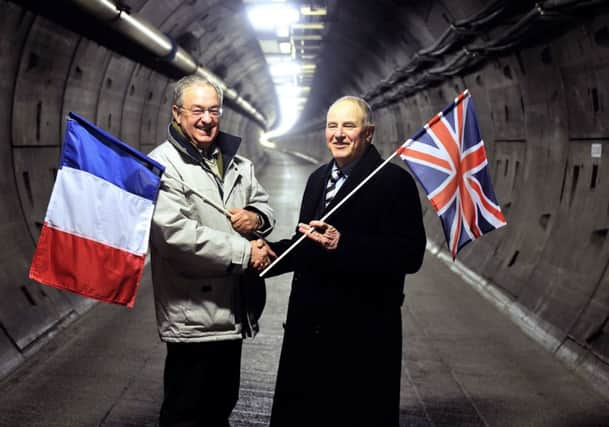Channel Tunnel celebrates 20 years


A reception and an exhibition on the history of the Folkestone to Coquelles link will be held at Eurotunnel’s terminal in northern France.
Formed of twin railway tunnels and a parallel service tunnel 100 metres below sea level, it is widely considered to be the 20th-century’s most important construction project.
Advertisement
Hide AdAdvertisement
Hide AdThe 31-mile tunnel has become a key part of Britain’s infrastructure after the Queen and François Mitterrand, then president of France, inaugurated it on 6 May, 1994.
A cross-Channel fixed link was first proposed in 1802 by French mining engineer Albert Mathieu, using oil lamps and horse-drawn stagecoaches.
The following year an Englishman, Henry Mottray, unveiled another cross-Channel link project – a submerged tunnel constructed from prefabricated iron sections.
For decades, the idea of a cross-Channel fixed link had been discussed, only for the plans to be discarded on security grounds.
But years of peace in Europe following the end of the Second World War finally encouraged UK and French leaders to go ahead with the project.
In July 1957, a Channel Tunnel Study Group was formed and three years later the group presented to the governments plans for a twin rail tunnel with a service tunnel.
Some 13,000 engineers, technicians and workers helped construct the tunnel, and 11 boring machines each weighing 1,100 tonnes were used in the excavation.
Since its opening in May 1994, 325 million passengers and 20 million trucks have travelled through the tunnel – the equivalent to five times the population of the United Kingdom.
Advertisement
Hide AdAdvertisement
Hide AdGeoff French, president of the Institution of Civil Engineers, said: “The Channel Tunnel is a true feat of engineering. It contains one of the longest segments of undersea tunnel in the world, established the first fixed link from England to Europe, and over 13,000 workers from England and France collaborated to realise the vision.”
Operations leader Christine Marsh, 60, from Dover, has worked at the tunnel from its opening – and recalled its early beginnings.
She said: “It was very quiet back then, everything was so new and exciting. We had to do a lot of training to face the challenges.
“I was here when the Queen visited. We all knew it was going to be a very big thing and that we were part of something new.”
From the start, the tunnel was dogged by controversy. Ten years after it opened, Eurotunnel had debts of £6.4 billion and original traffic forecasts proved to be wildly optimistic.
Today the picture is markedly different. Last year Eurotunnel achieved revenues of €1bn (£823 million) for the first time.
Last month Eurotunnel posted revenues of about £217m – up 8 per cent on January-March last year.
But it still faces stiff competition from cross-Channel ferry services and airlines.
Advertisement
Hide AdAdvertisement
Hide AdEurotunnel’s commercial director, Jo Willacy, said: “Commercially, it has been a tremendous success. One in two vehicles that now crosses the Channel, crosses with us.
“Not only that, but the market is bigger now as a direct result of the Channel Tunnel being brought to the market. It’s now hard to believe it didn’t exist.”